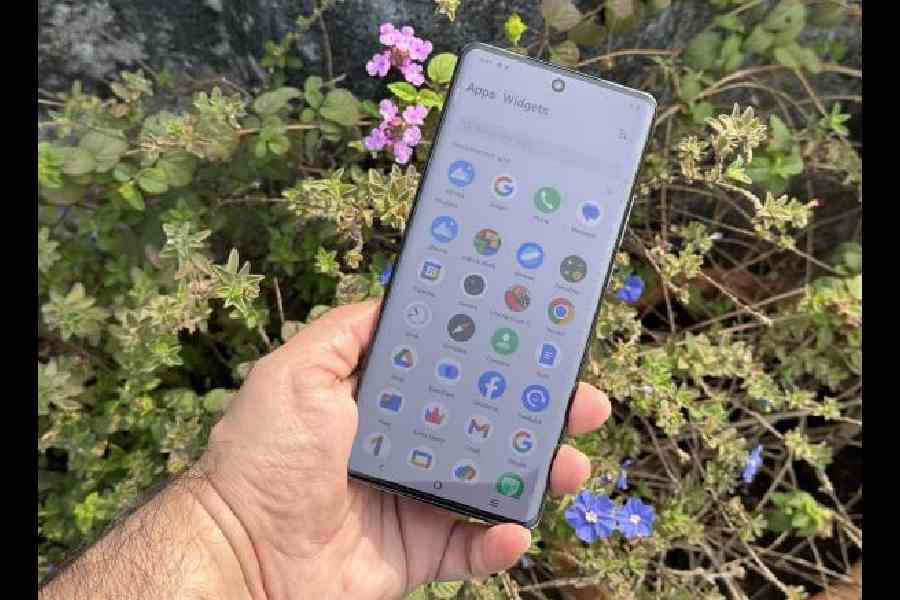In the last few years, one brand that has upped its camera game drastically is Vivo, to the point it is on the bleeding edge of mobile videography. It also means that the latest flagship number from the company has to live up to its past glories. Vivo X100 Pro is the phone most Android smartphones will compete with this year. With perfect launch timing, the phone has ‘winner’ written all over it.
Premium looks
The overall design is familiar. The phone has a slippery back to it and there is a shimmer effect to the frosted-style glass. It looks good but more importantly, it resists fingerprints. Next to the camera module, you will see dual-tone LED flash while the three cameras are each of 50MP. The periscopic lens offers 4.3x optical zoom, ultra-wide and then the main camera. Needless to say, there is optical image stabilisation on the main as well as telephoto cameras. The partnership with Zeiss is important. The coating on the lens cuts down on lens flare reflection.

Low-light capabilities of the phone is fantastic and there is zero shutter lag
The frame around the phone is metal and at 225g, it feels good to hold. But at a time when flagship devices are trying out new materials to bring down weight, Vivo should look at a new strategy in the coming years.
The charging port supports USB 3.1 speeds while the SIM tray accepts only two nano SIMs, so no micro-SD card support. Overall, the design is good and the phone feels sturdy. The only quibble I have is that the fingerprint scanner is lower down on the display, so I need to stretch my fingers to reach it. When it comes to functioning of the fingerprint scanner, it’s flawless.
The screen is roughly the same as the one last year. It’s a 6.78-inch screen but it now has 3,000 nits peak brightness and a refresh rate of 120Hz.
The display itself offers excellent palm rejection vis-à-vis some flagship phones that are notorious for freezing the camera. The screen has a good pulse width modulation refresh rate. It’s 2160Hz, resulting in zero flicker. As for the 3,000 nits of brightness, I was unable to measure the claim but from experience, the display can get very bright even under bright sunshine.
There are two options in the screen resolution department — 2800x1260 or super definition and 2,400x1,080 or high definition (meant to save power). I don’t know if this was necessary because I have kept the resolution to max and so will any other user. In the screen refresh rate department, you can set it to high but it’s best to choose “smart switch”.
Good UI but….
One of the best things about the phone is that it comes with Android 14 out of the box and on top of that is Funtouch OS 14. I’ve not encountered any bugs and there has already been a couple of firmware updates. It is good to see that Vivo is pushing out updates often. Also, there is no animation lag. When the LTPO display moves from 1Hz to 120Hz, there is no flicker. The overall performance of the UI is good. But there is an issue. This is a flagship phone and it doesn’t come cheap. As soon as I powered on the device, I was faced with Block Blast, Candy Crush, Netflix, PhonePe, Tile Master, Spotify, YouTube and YouTube Music. I understand that all of this can be removed but most people tend to leave the default apps on the phone because they feel it’s necessary to have them. The feeling of using a flagship phone gets marred with such pesky apps.

There is T* coating from Zeiss to tackles camera flare
Sustained performance
The review unit comes with 16GB RAM, 512GB of UFS 4.0 storage and Dimensity 9300 processor. It’s a good chip that’s on the lines of Snapdragon 8 Gen 3. The internal storage speeds are impressive. Everything runs fast when you use this phone. The chip offers good stability and there is very little throttling. The only throttling I noticed is when playing games over a long period of time. The phone can manage heat well but after playing 45 minutes of a demanding gaming title, there is slight throttling. Playing a game like Genshin Impact is fun and only when you are well into the game (keep graphics set to the highest), there is a slight dip in performance but it’s nothing to worry about. And I am talking about 45-60 minutes of gaming. When it comes to everyday work and apps, it’s the phone to have.

The telephoto lens on the camera does a good job and the 4.3x zoom goes toe to toe with other premium Android phones
Vivo has thrown in a few important things — NFC support, Widevine L1 support to handle all your streaming service needs, excellent network reception (missed calls got tackled well during our review period) and IP68 rating.
The battery is well-tuned and the chipset helps to keep the battery ticking over the entire day. In real-world use, I got around eight and a half hours of screen-on time, while keeping it on dynamic refresh rate and screen resolution turned up. I find battery life to be better than expected. The charge time for me was around 27 minutes. It would have been lower had I not been using the phone while charging.
Voice calls sound great with noise cancellation. The phone has good haptics with a nice pulse to it. The speakers are quite loud and well-tuned. Watching videos even without attaching earbuds is a treat.
A magician who prefers the night
When it comes to camera performance, Vivo is among the best as far as low-light camera performance from its main camera is concerned. It is the IMX 989, so it’s a one-inch type sensor. We have a 50MP ultra-wide with a 4.3x zoom on the telephoto. The rear cameras have the T* coating from Zeiss, so they’re continuing that partnership again, which makes a difference.

The phone has an excellent processor but for a premium phone it has too much bloatware
First, the high points. There is excellent image stablisation and at night, photographs come out good. What Vivo has managed in the last few years in the camera department deserves a big round of applause and it is now capable of going toe to toe with any flagship phone.
The camera that has impressed me the most is telephoto. There is richness of details with no distortion around the edges. And the colours are true to life. Low-light performance and dynamic range on this phone are top-notch. The floating lens technology that has been used for the periscope makes a difference. Up to 10x photos have a high degree of crispness. But 100x? I think it can be better… not just on Vivo phones but on every other brand that’s offering the feature.
What new has Vivo done? Take a picture while facing the sun. The output has good hues without overexposing the overall photo. Portrait photography too has been improved, be it 23mm, 35mm, 50mm, 85mm or 100mm. The last mentioned is terrific, night or day. And the Zeiss natural colour mode can quickly become your favourite because skin tones get replicated very well.
What’s disappointing? The premium phone’s front-facing 32MP camera doesn’t shoot videos beyond 1080p@60fps. If you look at the camera from the perspective of only a front-facing snapper, I am all right with this limitation, especially because the stablisation is good. But when I am shooting a 4K video on the rear camera and as a vlogger, I want to switch to the front cam? It won’t allow me. What makes this a drawback is when you consider what can be done using the rear camera — shoot videos at 8K. For a premium phone, the ability to shoot 4K videos on the front camera needs to be there.
To Vivo’s credit, when you are switching between lenses on the rear while capturing a video, it’s very smooth.

Try to capture a full-resolution shot and work on the colour profile using a third-party app
Should you buy it?
It’s good to see Vivo improving on its biggest strength — the camera. Besides a few quibbles, the phone has everything you need. But what I still don’t understand is the bloatware and the reason behind giving 4K video a miss on the front camera. Vivo includes its 120W charger in the box, which is a good move as most flagship phones have stopped giving one. And there is support for 50W wireless charging. The brand is promising four years of software upgrades, so the X100 Pro should last a long time. If you are an amateur photographer looking for a good Android phone, this is a good choice. There are enough reasons for Vivo to take a victory lap.










